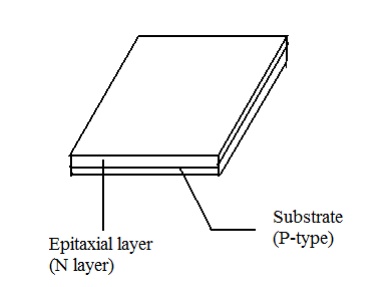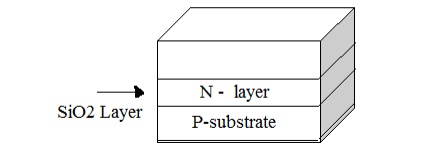The fabrication of a monolithic transistor includes the following steps.
1. Epitaxial growth
2. Oxidation
3. Photolithography
4. Isolation diffusion
5. Base diffusion
6. Emitter diffusion
7. Contact mask
8. Aluminium metallization
9. Passivation
The letters P and N in the figures refer to type of doping, and a minus (-) or plus (+) with P and N indicates lighter or heavier doping respectively.
1. Epitaxial growth:
The first step in transistor fabrication is creation of the collector region. We normally require a low resistivity path for the collector current. This is due to the fact that, the collector contact is normally taken at the top, thus increasing the collector series resistance and the VCE(Sat) of the device.

The higher collector resistance is reduced by a process called buried layer as shown in figure. In this arrangement, a heavily doped ‗N‘ region is sandwiched between the N-type epitaxial layer and P – type substrate. This buried N+ layer provides a low resistance path in the active collector
region to the collector contact C. In effect, the buried layer provides a low resistance shunt path for the flow of current.
For fabricating an NPN transistor, we begin with a P-type silicon substrate having a resistivity of typically 1Ω-cm, corresponding to an acceptor ion concentration of 1.4 * 1015 atoms/cm3 . An oxide mask with the necessary pattern for buried layer diffusion is prepared. This is followed by masking and etching the oxide in the buried layer mask.
The N-type buried layer is now diffused into the substrate. A slow-diffusing material such as arsenic or antimony us used, so that the buried layer will stay-put during subsequent diffusions. The junction depth is typically a few microns, with sheet resistivity of around 20Ω per square.
Then, an epitaxial layer of lightly doped N-silicon is grown on the P-type substrate by placing the wafer in the furnace at 12000 C and introducing a gas containing phosphorus (donor impurity). The resulting structure is shown in figure.
The subsequent diffusions are done in this epitaxial layer. All active and passive components are formed on the thin N-layer epitaxial layer grown over the P-type substrate. Obtaining an epitaxial layer of the proper thickness and doping with high crystal quality is perhaps the most formidable challenge in bipolar device processing.
2. Oxidation:

As shown in figure, a thin layer of silicon dioxide (SiO2) is grown over the N-type layer by exposing the silicon wafer to an oxygen atmosphere at about 10000 C.
3. Photolithography:

The prime use of photolithography in IC manufacturing is to selectively etch or remove the SiO2 layer. As shown in figure, the surface of the oxide is first covered with a thin uniform layer of photosensitive emulsion (Photo resist). The mask, a black and white negative of the requied pattern, is placed over the structure. When exposed to ultraviolet light, the photo resist under the transparent region of the mask becomes poly-merized. The mask is then removed and the wafer is treated chemically that removes the unexposed portions of the photoresist film. The polymerized region is cured so that it becomes resistant to corrosion. Then the chip is dipped in an etching solution of hydrofluoric acid which removes the oxide layer not protected by the polymerized photoresist. This creates openings in the SiO2 layer through which P-type or N-type impurities can be diffused using the isolation diffusion process as shown in figure. After diffusion of impurities, the polymerized photoresist is removed with sulphuric acid and by a mechanical abrasion process.
4. Isolation Diffusion:
The integrated circuit contains many devices. Since a number of devices are to be fabricated on the same IC chip, it becomes necessary to provide good isolation between various components and their interconnections.
The most important techniques for isolation are:
1. PN junction Isolation
2. Dielectric Isolation
In PN junction isolation technique, the P+ type impurities are selectively diffused into the N-type epitaxial layer so that it touches the P-type substrate at the bottom. This method generated N-type isolation regions surrounded by P-type moats. If the P-substrate is held at the most negative potential, the diodes will become reverse-biased, thus providing isolation between these islands.
The individual components are fabricated inside these islands. This method is very economical, and is the most commonly used isolation method for general purpose integrated circuits.
In dielectric isolation method, a layer of solid dielectric such as silicon dioxide or ruby surrounds each component and this dielectric provides isolation. The isolation is both physical and electrical. This method is very expensive due to additional processing steps needed and this is mostly used for fabricating IC‘s required for special application in military and aerospace.
The PN junction isolation diffusion method is shown in figure. The process take place in a furnace using boron source. The diffusion depth must be atleast equal to the epitaxial thickness in order to obtain complete isolation. Poor isolation results in device failures as all transistors might get shorted together. The N-type island shown in figure forms the collector region of the NPN transistor. The heavily doped P-type regions marked P+ are the isolation regions for the active and passive components that will be formed in the various N-type islands of the epitaxial layer.
5 Base diffusion:
Formation of the base is a critical step in the construction of a bipolar transistor. The base must be aligned, so that, during diffusion, it does not come into contact with either the isolation region or the buried layer. Frequently, the base diffusion step is also used in parallel to fabricate diffused resistors for the circuit. The value of these resistors depends on the diffusion conditions and the width of the opening made during etching. The base width influences the transistor parameters very strongly. Therefore, the base junction depth and resistivity must be tightly controlled. The base sheet resistivity should be fairly high (200- 500Ω per square) so that the base does not inject carriers into the emitter. For NPN transistor, the base is diffused in a furnace using a boron source. The diffusion process is done in two steps, pre deposition of dopants at 9000 C and driving them in at about 12000 C. The drive-in is done in an oxidizing ambience, so that oxide is grown over the base region for subsequent fabrication steps. Figure shows that P-type base region of the transistor diffused in the N-type island (collector region) using photolithography and isolation diffusion processes.
6. Emitter Diffusion:
Emitter Diffusion is the final step in the fabrication of the transistor. The emitter opening must lie wholly within the base. Emitter masking not only opens windows for the emitter, but also for the contact point, which provides a low resistivity ohmic contact path for the emitter terminal.
The emitter diffusion is normally a heavy N-type diffusion, producing low-resistivity layer that can inject charge easily into the base. A Phosphorus source is commonly used so that the diffusion time id shortened and the previous layers do not diffuse further. The emitter is diffused into the base, so that the emitter junction depth very closely approaches the base junction depth. The active base is then a P-region between these two junctions which can be made very narrow by adjusting the emitter diffusion time. Various diffusion and drive in cycles can be used to fabricate the emitter. The Resistivity of the emitter is usually not too critical.
The N-type emitter region of the transistor diffused into the P-type base region is shown below. However, this is not needed to fabricate a resistor where the resistivity of the P-type base region itself will serve the purpose. In this way, an NPN transistor and a resistor are fabricated simultaneously.
7. Contact Mask:
After the fabrication of emitter, windows are etched into the N-type regions where contacts are to be made for collector and emitter terminals. Heavily concentrated phosphorus N+ dopant is diffused into these regions simultaneously.
The reasons for the use of heavy N+ diffusion is explained as follows: Aluminium, being a good conductor used for interconnection, is a P-type of impurity when used with silicon. Therefore, it can produce an unwanted diode or rectifying contact with the lightly doped N-material. Introducing a high concentration of N+ dopant caused the Si lattice at the surface semi-metallic. Thus the N+ layer makes a very good ohmic contact with the Aluminium layer. This is done by the oxidation, photolithography and isolation diffusion processes.
8. Metallization:
The IC chip is now complete with the active and passive devices, and the metal leads are to be formed for making connections with the terminals of the devices. Aluminium is deposited over the entire wafer by vacuum deposition. The thickness for single layer metal is 1μ m. Metallization is carried out by evaporating aluminium over the entire surface and then selectively etching away aluminium to leave behind the desired interconnection and bonding pads as shown in figure.
Metallization is done for making interconnection between the various components fabricated in an IC and providing bonding pads around the circumference of the IC chip for later connection of wires
9. Passivation/ Assembly and Packaging:
Metallization is followed by passivation, in which an insulating and protective layer is deposited over the whole device. This protects it against mechanical and chemical damage during subsequent processing steps. Doped or undoped silicon oxide or silicon nitride, or some combination of them, are usually chosen for passivation of layers. The layer is deposited by chemical vapour deposition (CVD) technique at a temperature low enough not to harm the metallization.

